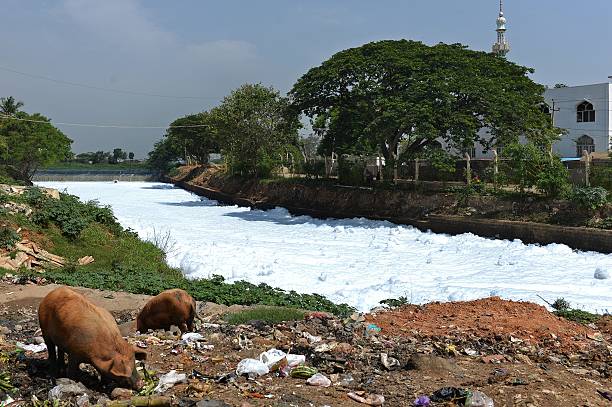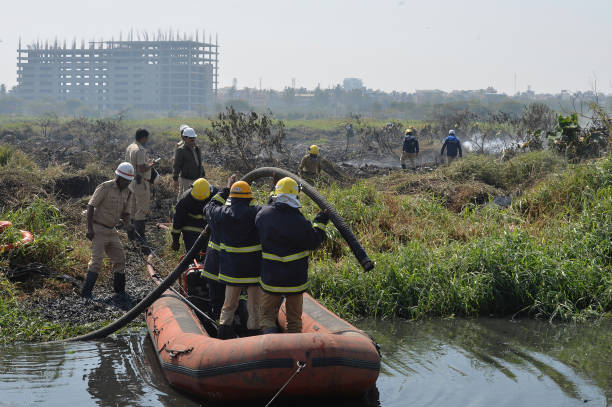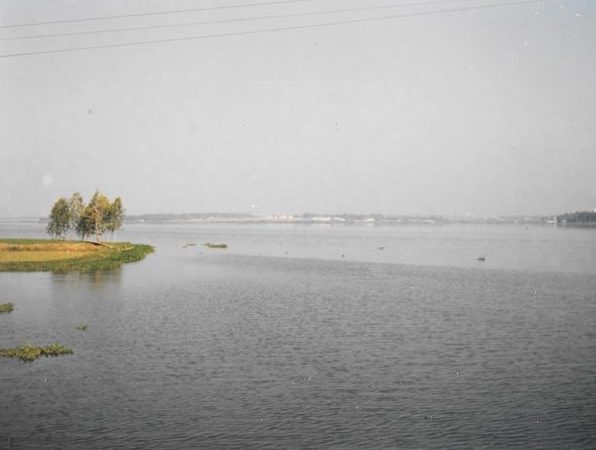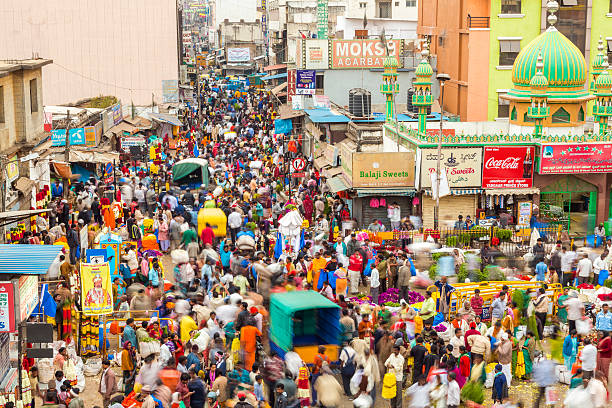A Lake of Fire, A Runaway Goddess, and the Perils of Climate Change in India
Have the goddesses and gods of Hinduism fled because the planet is too polluted?

(A canal from Bellandur Lake in Bangalore, India is covered in toxic suds. Photo credit: MANJUNATH KIRAN via Getty Images.)
“When the close of the thousand aeons has come and life has been spent, there befalls a drought of many years that drives most of the creatures, of dwindling reserves and starving to their death. . . . The Fire of Annihilation then invades . . . [and] burns down all that is found on earth. . .”
—Mahabharata (c. 500–200 B.C.E. Translated by J. A. B. van Buitenen)
When the Water Burns…
On February 17, 2017, the two-mile-long Bellandur Lake in my hometown of Bangalore, India caught fire. Blueish-red flames broke out on the water. Smoke billowed from the water’s surface, carrying the putrid smell of raw sewage and acrid chemical pollutants across the Iblur village at its shore. For several years before this fire, dense white foam covered the lake. The surface of the water, an oily sudsy smelly grey, could only be glimpsed when the froth broke up. Because of the fire, trees on the lakeshore, green a decade before, were now ashen, ghostly relics. Smoke blackened the walls of a shrine dedicated to the goddess Kateriamman, a wilderness goddess, revered as the keredevaru, or the “Goddess of the Lake.” It charred the branches of the sacred Peepul tree and the snake shrines beneath it. The winds that swirled through the hillsides of the city blew a soapy froth into the streets, where it covered vehicles and pedestrians alike in a stinging sudsy film.
A month after the fire, someone sent me an unaired video interview for a Bangalorean television network with a woman named Gauri. She was a middle-aged woman of the Tigala (horticulturist caste) and a resident of Iblur village. In the interview, she haltingly said she had grown up near the water in a traditional horticultural family. She spoke powerfully of her memories of the once-verdant landscape: there had been beautiful sacred copses of green trees and the lake’s blue waters were studded with pink lotus blossoms that her family harvested to worship the goddess Kateriamman.
Standing in front of the small temple, Gauri recalled the once crystal-clear underground stream that bubbled beneath the deity and flowed into the sacred lake. She evoked the Hindu poetic myths of the sacred region, in Sanskrit termed the sthalapurana, or “the myths of sacred place,” to describe the area. Visible behind her were the toxic suds that had engulfed the edge of the once-beautiful body of water.
Gauri gestured despairingly toward the fiery lake and the shore littered with plastic bags, feces, dead fish, and refuse. She exclaimed, “The lake is burning. We live in this world of filth. This sthalapurana has become a terrifying tale.” She paused, rendered breathless by the stench of the water, a mix of sewage and chemical bleach. She asked, her voice rising in anger, “Do you see this mess? The water burns…My lungs are on fire! Look at it… What hell (naraka) is this?” She then pointed to the temple and cried, “The Lake Goddess is now absent, raped by these developers! Maybe She has run away from this hell!”

(Firefighters extinguish a fire on Bellandur Lake. Photo credit: MANJUNATH KIRAN via Getty Images.)
Rocked by a paroxysm of coughing, tired from grief and anger, she asked with rising apprehension, “How can anyone live without water? What life is this?”
Water in Hinduism
The loss of water is a potent question for a religion like Hinduism, where water is thought to be a divine fluid and a gift of the gods’ grace and kindness. For Hindus, water is sacred, the origin of all reality, offering a sense of lucent possibility, a new rising, a birth and a rebirth. Of the Hindu Vedic corpus, the oldest text, the Rig Veda, complied about 3700 B.C.E. speaks of water, (known as ap in Sanskrit,) as primordial, contained in an egg from which everything else was born. The world was said to have been “originally water without light” where “there was darkness, wrapped around by darkness, and all around was water” (Salilam apraketam; Rig Veda X.29.3).
The Rig Veda also suggests that several gods embody water. Apas is the god of waters. Indra is god of the storm. Varuna is god of the sky and upholder of natural law, a god referred to in the texts directly and indirectly as connected to water. And finally, we find Parjanya, the god of the raincloud, who represents water in the form of rain, which sustains life on Earth and creates a bridge to the heavens. Hindus consider the water falling from the heavens to Earth — including the monsoon rains that soak the subcontinent and form rivers and lakes — as a material and spiritual bridge between the two realms of life and death.
Rivers and water bodies are feminine goddesses in Hinduism, known for their fertility and beauty, who were made to descend from the heavens by human vows and penances, bringing abundant life to India’s arid earth through their pure waters. Moral dirt, or what Western traditions call sin, known as papa in Sanskrit, is perceptible as physical dirt in these pure waters, all of which are seen as evocations of the great river goddess Ganga, purifier of all beings.
Hindus have assimilated water into their everyday lives, where its otherworldly origins are made more potent and yet more manageable. Hindus use water to bathe the idols of the gods (abhishkam), to consume as sacred water (tirtha), and to purify the world at large (prokshanam). Water is thus primeval and essential in Hinduism – an elixir of earthly life but also a sacred being with life of its own. Water purifies bodies and ritual spaces. It cools parched people and deities alike.
But water as a godly being also needs care and nourishment.
The tension that Gauri’s despair points to – between the significance of water in Hinduism on one hand, and the sordid, polluted state of water in many populated areas of the subcontinent, on the other – forces us to reflect on Gauri’s existential question of a parched life where watery divinity is desiccated. In cosmological terms the question is one of the potential homelessness of the gods: where can the gods go when their homes are desecrated by pollution? In real world terms the question is of the existence of life on the planet: if water is life, what is a life without water?
From the City of Lakes…
A few centuries ago, Bangalore was home to a thousand or more sacred lakes and man-made rainwater catchment ponds called “tanks” in the local English. So ubiquitous were these bodies of water that Bangalore was known in antiquity as kalayananagara, or “the city of lakes.” Every lake had a resident god or goddess, its own keredevaru (gods of the lake) who locals worshipped using the lake’s water and the produce grown around it.
These water bodies known collectively as kere in Kannada, combined with the sacred river Cauvery, formed a unique watery ecology in the Deccan plateau region. Canals known as rajakaluve (royal canals) led from one kere to another alongside natural streams, distributing excess water by gravity via check dams and locks and thereby allowing the entire region to soak up rainwater and prevent flooding. Far from rivers and oceans, the agrarian area that is now Bangalore depended on this riparian system.

(Bellandur Lake in 1989. Photo courtesy of Praveen Singh via The News Minute.)
Agaram Lake, a large body of water upstream from Bellandur, has also been covered with toxic foam in recent years. Archeologists have found stone tablets at Agaram’s shore, covered in slime, with inscriptions dating to the 9th century that speak of its usage for drinking water and agriculture. Enlightened medieval rulers of Bangalore, including feudatory lords such as Kempegowda (approximately 1513- 1570) and Muslim rulers such as Hyder Ali (1720-1782), excavated kere and built rajakaluve to save and transport rainwater. Constructing lakes and canals were spiritual endeavors for leaders of all faiths, guaranteeing punya or merit in the karmic scale. Kings gave the lakes as sacred gifts, known as bittuvate, to the gods. In return, the gods granted them the right to farm by the lakes and to fish from them.
In the 1970s, there were still 285 of these sacred lakes in Bangalore, making the city self-sufficient in its water needs.
…to the Parched City
But today, Bangalore has fewer than 80 lakes.
In the 1990s the city became home to a successful Information Technology industry. Known as “The Silicon Valley of Asia,” Bangalore has since been subject to unchecked urbanization. The many software companies that sprung up during the dotcom boom of the late 1990s attracted hundreds of thousands of skilled IT professionals from across the country, with thousands more unskilled migrants moving from villages and small towns to the city in search of work. As a result, the city’s population doubled between 2000 and 2020 from 6 million to 12 million.
According to studies by the Indian Institute of Science in the city, rapid urbanization and development is making the city uninhabitable. There has been a 1005% increase in paved surfaces and a decline of 88% in the city’s vegetation between 1973 and 2016. The size of Bangalore has more than tripled in just over a decade to 800 square km– nearly half the size of London — swallowing open land. Developers, in collusion with corrupt city government officials, have encroached upon the sacred kere system, dumping construction rubble and raw sewage into the lakes.
And so, Bangalore can no longer sustain its water resources. The city is perennially thirsty.
The Cost of Thirst
Every day, Bangalore pumps 1.4 billion liters of water through its pipes, but still fails to meet the city’s needs by over 800 million liters. Rolling managed droughts are a reality of city life, especially in the increasingly hot summers; the government announces which neighborhoods will get a few hours of water supply every few days.
Most of Bangalore’s drinking water comes from the sacred Cauvery River that is over 60 miles away from the city. The Bangalore Water Supply and Sewerage Board was established as India’s first water-supply management board and, as such, it carried the onus of carting the Cauvery to the city, which is elevated over 1,500 feet above the river. The scheme became operational in 1971 with huge pumping stations to pump the water uphill.
By 2016, the city had pumped 1,400 million liters of water a day from the Cauvery River. And this water comes at a prohibitive cost: $48.9 million in 1993, $150 million each year between 1997-2002, and $450 million in 2013. Today, the city still suffers from a water deficit. As a result of its unchecked development and rapid growth, the city now requires 1,700 to 1,800 million liters every day from the Cauvery River. In summer, the demand shoots up to 2,100-2,200 million liters daily. And over a million liters are lost per day from leakage and theft. This is no well-kept secret; several reports on the state of Bangalore water supply describe the urgency of water scarcity and the disruptive effects of water insecurity on residents’ lives.

(Bangalore, India. Photo credit: Getty Images.)
As early as 1991, despite the constant and costly pumping of Cauvery water to the city, water was so scarce that residents started digging private piped borewells into the city’s aquifer, where they hit clear, pure water at 100 feet. Bangalore has no laws preventing private drilling and many new communities built on the city’s edge get all their water needs met by draining the aquifer.
Many roadways in the city developed huge sinkholes that swallowed buildings whole as the groundwater was sucked up through these giant straws, destabilizing the earth underneath the city.
Today, as the city population climbs to over 12 million, borewells sink deeper and deeper into the earth. Borewell operators say they must now dig 1,000 feet to hit water, almost as low as the River Cauvery. As the water table in the aquifer sinks, the kere get drier and drier as gravity drains the lakes, rivers, and swamps to feed the aquifer.
The story of Bangalore’s galloping water scarcity and the mismanagement of its water resources, raises the question of whether we can nurture nature. Have we so polluted these natural resources that they can no longer recover? Can we come to grips with the intersecting and multiplying problems of climate change? Is it possible to increase the capacities of religion, spirituality, and ethics to meet these challenges?
At the Edge of the Abyss…
A small dark granite image of the deity Kateriamman sits in the temple at Bellandur. She is both the goddess of the lake and, as the priest of the temple tells me, the goddess of the edge, enu nalli, because her temples sit between land and water, between the wilderness and the cultivated. But Kateriamman sits on another edge as well—the edge of the abyss of total ecological collapse.
An Indian water crisis is looming and Bangalore will be ground zero for it. On June 19, 2018, the National Institute for Transforming India, an Indian government think tank, warned that India’s water shortage is perilous. Over 600 million people will be affected by it. In developing countries like India, women are usually tasked with foraging for water for the family, often carrying it for miles. Water shortages will most likely affect women and the urban poor, women like Gauri.
As scholars of Hinduism have noted, in Hindu texts there is a close yet oppositional link between dharma (righteousness, duty, justice; from dhr, or that which sustains) and the despoiling of the Earth, particularly of water. When dharma declines, human beings despoil nature.
The lakes of Bangalore have been ruined by rapid urban development. Land prices in the city skyrocketed 1,000% in the last two decades, and so the land under the water of the lakes was more valuable to developers than the waterbody itself. There has been a systematic if erratic process over the past 30 years to deaden the lakes, to desiccate them, so that they can be encroached upon even more. Over 100 lakes have been lost since 1970 to encroachments by the Bangalore Development Authority, to real estate developers, to garbage dumps, and to illegal buildings.
The remaining lakes that have water, such as Bellandur, are dumping grounds for construction rubble, outfalls of sewage and industrial pollutants, and toxic algae, though they are surrounded by some of the most expensive real estate in India. An estimated 500 million liters of untreated sewage reaches Bellandur Lake every day, combined with a cocktail of chemicals from small-scale manufacturing – mills, printers, dyers, and metal works plants – creating a “toxic community” around it. People who live around the lake cough constantly, and often get bronchitis and other lung diseases.
The cost of this pollution is staggering. The World Bank noted that in 2017 India spent over $600 million treating water-borne diseases. With increasing pollution, a massive public health crisis is brewing in India’s metastasizing cities.
At Bellandur, the global and intimate violence of climate change and development have come home to roost. Prime Minister Modi’s high profile 2014 Swachch Bharat (“Clean India”) campaign to address India’s pollution collided with his government’s focus on industry, modernity, and development, leading the campaign to be relegated to a few well-circulated photo-ops of elected officials wielding new brooms in already clean streets. Meanwhile, Indian air and water pollution increased, protected forests were illegally logged and mined, and cities were trashed.
Experts fear that Bangalore will soon be uninhabitable. And though the city municipal government has claimed it will clean up the lakes in 2022, and the National Green Tribunal has issued legal notices to all of the agencies involved, the lake continues to be a toxic mess. Municipal leaders have been apathetic at best and negligent at worst, even blaming the Tigala horticulturists by suggesting that they set the fires to clear vegetation. The city government also claimed there was no toxic smell on the lake and that the air was clear, though citizen activist groups easily disputed such claims, calling Bellandur a huge “septic tank.”
Manjunatha, a shopkeeper in the neighborhood of Iblur, said, “Issues such as a major fire or toxic foam or an unbearable stench have become a common phenomenon in this area. When these occurred for the first time in 2015 and 2016, they were huge spectacles. But nowadays these appear to have become a new ‘normal’ in our area.”
Gauri and others who live near Bangalore’s remaining lakes say the keredevaru, the divine beings that inhabit water, have fled because of the pollution and the lack of care for their homes.
Where do water gods go when the world is desiccated? How do Hindus, in the creative complexity of how they value, define, express and practice ethics, approach the Age of Climate Crisis? Or, simply put, is the Hindu religious imagination being eviscerated by climate change?
If, as Mohamed Meziane recently noted, secularization is a defining feature of modernity’s birth, then it is natural to ask: did secularization engender climate change? Is secularization an uncomfortable inheritance of colonialism and also a set of eroding ecological processes? This does not imply that we simply critique secularism, or unthinkingly pivot to poisonous Hindu fundamentalism. Rather, we must reject fundamentalism and its unholy alliance with modern neoliberal development. Re-turning to religion, we have to ask ourselves: what does the moral stewardship of this Earth involve? And can religion afford us a vocabulary and tactics to enact such stewardship that restores our ecological resources?
A Way Forward…
Gauri’s lakeside requiem demands from us, at the very least, to take water seriously, as anthropologist Stefan Helmreich suggests, as “good to think with.” As many anthropologists have argued, we need to re-center water as natural and elemental to life, including religious life. Thinking about water within the context of religion suggests that religions like Hinduism need to be re-examined in light of the current environmental crisis, as religion helps to shape our attitudes toward nature in both conscious and unconscious ways.
Religions provide basic interpretive stories of who we are, what nature is, where we have come from, and where we are going. What people do about their ecology depends on what they think about themselves in relation to nature. And religious worlds create ethical and moral frameworks that structure how we think of nature as either exploitable or as needing stewardship.
As life on the planet is unraveling in ways both seen and unseen, Gauri’s elegy for the runaway goddess suggests that the fragile understanding of the lake as a sacred being worthy of protection has dissolved in the face of modern urban development. The question that Gauri leaves us with is this: can people of faith reconstruct an understanding of the wilderness as sacred to win the ecological battle against the forces of development? Can we pledge to restore the planet enough to persuade the goddess to return to the lake?
Tulasi Srinivas is professor of anthropology, religion and transnational studies at the Marlboro Institute of Interdisciplinary Studies at Emerson College. Her next book The Missing Goddess, focuses upon women, water and eco-violence in her hometown of Bangalore.
***
Interested in more on this topic? Check out the short documentary The Burning Lake by Tulasi Srinivas.
***
The author would like to offer these acknowledgements: I am grateful to the Luce-ACLS fellowship in Religion, Journalism and International Affairs which I received in 2017-18, for allowing me time to think about Bangalore’s burning lakes. The Luce-ACLS invited me to give a keynote at a conference at Arizona State University, where I developed some initial ideas for this paper and some enduring friendships sharing concerns for the environment. I am particularly grateful to Toby Volkman of the Luce Foundation and Prof. Ann Gold for their generous mentorship. My colleagues at Emerson College—Dean Amy Ansell, Professors Wyatt Oswald and Jon Honea—have been invaluable intellectual partners. Prof. Jack Hawley, whose friendship has been such a gift, invited me to speak at Columbia University in the South Asia seminar series, which developed this article further, as did Prof. Tuhina Ganguly at Shiv Nader University for their Monsoon series, and Prof. Vandana Madan at Delhi University. I am grateful to them all. Additionally, I thank Vishwanath Srikantaiah of Biome Environmental Solutions, Bangalore for his time and help. And finally, my gratitude to the editors of the Revealer for inviting me to contribute this piece.